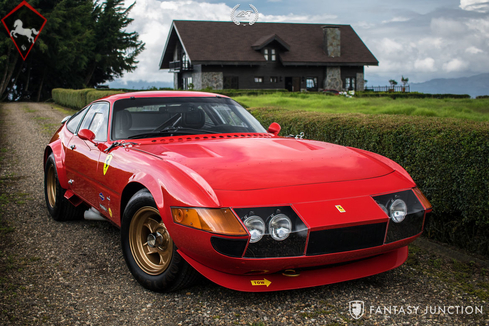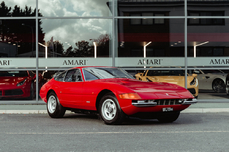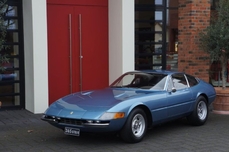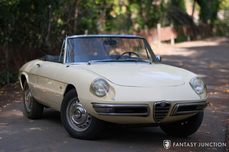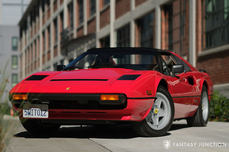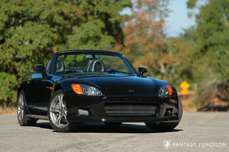Ferrari 365 GTB/4 Daytona 4.4 Liter Quad-Cam V12 1971
Allgemeine Beschreibung :
1971 Ferrari 365 GTB/4 Daytona Competition Specification
s/n 13383
Rosso Corso with Black Leather Interior
The V12 flagship 365GTB/4 “Daytona” arrived in 1968 at the Paris Auto Show, much to the joy of enthusiasts everywhere. Unofficially named the Daytona by the press, commemorating the recent 1-2-3 finish by Ferrari at 24 hours of Daytona, the media name stuck and rightly so – the car and the win was inspirational for Ferrari and critical to their future. The Daytona featured a landmark Pininfarina body design, capturing a crisp, modern look with reverence to classic GT cars of the past. Given the mid-engine surge from Lamborghini and other sports car manufacturers, the Daytona might have been considered dated, but performance quelled any doubts in 1971 when Dan Gurney and Brock Yates won the rigorous Cannonball Run in their Daytona at an average speed of 80.1 mph across 3,000 miles of America.
Technical specifications included a 4.4 liter quad cam Colombo V12 engine producing over 350hp, linked to a rear-mounted 5-speed transaxle, delivering optimal weight distribution. With independent suspension, disc brakes at all four corners and superb weight balance, the Daytona was extremely fast (174mph top speed) and quick (0-60 in 5.3 sec). Just 1284 Daytonas were produced before yielding to the mid-engine Berlinetta Boxer. And while the majority of the press and public awareness was centered around the premier road car performance, after 500 units had been produced, FIA homologation for International Group 4 Special Grand Touring allowed Ferrari to prepare a limited number of Competizione versions for customer use. This series included fabricating an all alloy body similar to the thin alloy units prepared for the 1969 Le Mans 24 Hours. The factory cars also included a roll cage, wider rear tires and fender flares, front fender stabilizer blades (which improved front end aerodynamics at high speeds), special side exhaust, and a cold airbox to aid air flow to the Weber carburetors. By 1972 the cars were competing to a high level of success, particularly with privateers through the 1970s adding several subsequent modifications and improvements to these specialized cars.
This particular competition prepared car was originally built as a factory road car in white with black interior. The car was delivered new to an Italian client in 1971. Later sold to Japan, the car was imported to England in 2004 where the owner at that time embarked on carefully documented construction to Series 1 competition Group 4 specifications. During this construction, the Series 1 modifications began by carefully removing the factory body shell and installing an FIA roll cage. Expert fabricator Steve MacFarlane then fabricated a stunning alloy body enveloping the factory chassis using 1.2mm thickness alloy construction per original Competizione specifications. The wheel openings were flared to allow the correctly sized front and wider rear magnesium wheel and tire combination. The headlight configuration was also fabricated to competition standards with correct Plexiglas covers. Plexiglas sliding side windows and rear window were also installed per original specifications. A competition outside fuel filler cap was also added, directly feeding a large capacity FIA fuel cell located in the boot.
The engine remained in standard trim, rebuilt with high compression pistons and standard camshaft specifications, further updated with Roelofs competition exhaust manifolds. The Weber carburetors were fitted with competition inlet trumpets and a hand formed cold air intake positioned above the radiator. Tim Adams Racing Engines dyno tested the engine. The resulting power makes for a very exciting car on the track, while remaining very tractable for road use.
After completion of the initial build, the car was shipped to Portugal where it was race-prepared by Lorenzini Autosports of Lisbon and granted FIA HTP. The car was track tested at Estoril before being stored away with less than 3 hours logged on the motor. The car was then further updated including the current fresh red paint and racing livery, and engine upgrades. At this time, larger rear fender flares were added as well as induction cowl venting, updating the car to reflect some of the best attributes of the second and third series Competizione cars.
Most importantly, the accompanying FIA papers confirm the chassis to be of correct period specifications, correct adjustable coil platform suspension, fitted with a roll bar, six correct Weber 40 DCN 21 carburetors, using electric fuel pump, and a dry sump lubrication system. A large capacity ATL fuel cell (with FIA compliance) occupies a large portion of the trunk and an approved fire suppression system is properly fitted to the car with dashboard activation easily at hand. Additionally, the car is equipped with a power steering unit, modern twin electric cooling fans, and dual-mode air conditioning, all of which are welcome upgrades particularly on long distance or summer driving events.
Today this Daytona presents as a stunning example representative of the originally built but rarely seen factory Competizione cars. Every detail of the factory construction including the rare exposed headlight configuration, thin front fender high-speed stability blades, deep-angle front spoiler, and flared fender construction are all beautifully configured as part of the hand formed alloy body. The all alloy body is exceptionally well-made with excellent construction including correct exposed rivet construction with beautiful glossy red paint. The finishes are not only beautifully done, the car is correctly outfitted with proper features such as a front tow hook, correct recessed exterior electrical cut off, polished aluminum fuel filler, and chrome finished side marker lights.
The doors, hood, and trunk open and close with excellent panel fit, itself a remarkable feat given the aluminum construction. Emblems, lighting, and various trim are further in excellent condition, with both front and rear valances cleanly shaped without bumper detail. The side openings have been replaced with correctly fabricated Plexiglas features and proper trim supporting the perimeter mounts. The wicked and pounce-like stance is enhanced by competition inspired satin gold Cromodora wheels, which are in very nice condition. The wider rear wheel and tire configuration (26.5 or 10.4” x 15”) and correct front size Goodyear racing tires complete the competition appearance of this remarkably constructed car.
The interior is a stunning combination of original Ferrari Daytona features including beautifully finished correct leather seating with perforated inserts, a correctly replicated racing dashboard, and exceptional interior accents. The dashboard has a well-composed combination of original style instruments and racing toggle switches, coupled with an exposed gated shifter, correct Ferrari, steering wheel, modern Simpson competition seat belts, and foot rest bars dedicated to the fortunate passenger. The factory round dash vents deliver cold A/C to the cabin via a two-stage toggle switch on the central panel. The general interior presentation throughout is one of high quality, combining important safety upgrades, originality, and historically correct Competizione features.
The engine and engine compartment further exemplify the thoughtful combination of original features and finishes, blended with racing details and uniquely fabricated parts. The engine has been professionally rebuilt and restored using correct finishes, proper hardware, and assorted Ferrari components. The six dual-throat Weber carburetors are beautifully finished with polished velocity stacks, surrounded by a hand-formed aluminum forced-air intake tray, which delivers a nice contrast to the clean and honest representations of the factory crackle black Ferrari cam covers and custom racing exhaust. The finish details include proper wiring, correct hoses, and an assortment of specially made parts, which have been either hand built or refined from original specifications. The underside is further evidence of a clean and professionally prepared car that has been properly addressed throughout the build and maintained amidst subsequent use. The chassis shows no visual evidence of damage or structural compromise.
Opening the lightweight alloy doors via the delicate factory door handle, the leather trimmed Daytona seat awaits just beyond a slight lift over the padded FIA side protection bar. A specific starting procedure to the electric fuel pump and ignition releases a V12 fury into a deep and throaty idle as the engine slowly warms. The engine climbs the revs, warming slowly as it comes to temp. Ready to engage, the throttle responds with a crisp, raspy voice, ready to go. The very light clutch takes up smoothly without shuddering and the gearbox works well, both cold and warm with excellent synchros. The suspension is taut and responsive, with a bit more stiffness than a typical road car, allowing for more aggressive cornering and power transfer when exiting corners. Brakes are non-power assist, and incredibly firm, meant to be warmed for competition use. Acceleration is similar to a road going Daytona until pushed into the higher revs where the engine delivers a welcomed boost of power that drivers will easily enjoy leveraging under more spirited driving conditions. The car is offered with select records, the FIA papers, a cover, and spare plexi headlight covers. Having been only minimally exercised since construction all aspects of the mechanical and cosmetic preparation are basically as-new. As always, we recommend the next owner engage a qualified racing specialty shop to perform a careful review and inspection of all mechanical components of the car prior to spirited competition use.
This truly exceptional matching numbers competition Daytona has been constructed by attentive experts with careful regard to Competizione specifications and appropriate modern racing updates to meet FIA requirements. Sold with FIA papers, this Competition Specification Daytona is ready to bring a new owner both street and event driving pleasure at a fraction of the cost of a multi-million dollar period construction example.
https://fantasyjunction.com/inventory/1971-ferrari-365-gtb-4-daytona-competition-specification/overview
1971 Ferrari 365 GTB/4 Daytona 4.4 Liter Quad-Cam V12 is listed verkauft on ClassicDigest in Emeryville by Fantasy Junction for $795000.
Fakten der Auto
Karosserietyp : Auto Marke : Ferrari Modell : 365 GTB/4 Daytona Ausführung : 4.4 Liter Quad-Cam V12 Hubraum : 4.4 Modelljahr : 1971 Lage : Emeryville Fahrzeug Anmeldung : Normal
Verkauft
Angaben Zum Verkäufer
Verkauft
People who viewed this Ferrari 365 GTB/4 Daytona also viewed similar Ferrari listed at ClassicDigest
Other cars listed for sale by this dealer
über Ferrari
Der erste Ferrari Straßenauto wurde die 125 S im Jahr 1947 eingeführt und angetrieben von einem 1,5 l-V12-Motor, oder?Nun, es ist nicht ganz so einfach, Ferrari in der Tat produzieren e Tipo 815, 1940 Tipo 815 wurde von Ex-Alfa Romeo Ingenieure Alberto Massimino und Vittorio Bellentani und von Enrico Nardi gesellschafts Enzos aber juristische Probleme mit dem ehemaligen Partner Alfa Romeo entwickelt verhindert Ferrari vom Start der Ferrari marque an diesem Punkt.
Enzo tat produzieren eine Reihe von feinen Straßenautos in den 50er und 60er Jahren, sondern sie lediglich zu seiner wahren Leidenschaft Renn, Wetter GT / Sportwagen oder Grand Prix finanzieren waren. Die 50-Jährige sah die Geburt von denkwürdigsten Autos Ferrari 250 GTB (Tour de France) 250 Testa Rossa, 250 GT SWB, nur um einige zu nennen.
Unter der Oberflächenspannung wurde aber wächst. In November 1961 langjähriger Vertriebsleiter Girolamo Gardini machte ein Ultimatum an Enzo: Wenn die Spannungen weiter, er das Unternehmen verlassen würde. Als Ergebnis wurde Gardini verdrängt sowie Scuderia Ferrari Manager Romolo Tavoni, Chefingenieur Carlo Chiti, experimentelle Sportwagen-Entwicklungschef Giotto Bizzarrini, und eine Reihe von anderen, die von ihnen stand.
Ohne Chiti und Bizzarrini die Entwicklung dessen, was war es, das die meisten Inbegriff Ferrari geworden und heute der weltweit teuerste Auto, 250 GTO wurde auf einem Drehpunkt. 250 GTO Projekt wurde von einem jungen Ingenieur Mauro Forghieri und langjähriger Renn Klempner Sergio Scaglietti, die in abgestuften und über das Programm mit bekannten Ergebnissen nahm gespeichert.
Neben 250 GTO, Ferrari launced solche Meisterwerke wie 250 LM, 250P, 275 GTB, 365 GTB / 4 "Daytona" Während der 60er Jahre
Durch den Erfolg der späten 60er Ferrari Prototypen 'zu einem plötzlichen Stillstand kam durch einen neuen Konkurrenten, GT40. Ford drehte sich zu Lola, einen Ferrari zu schlagen Fern racer produzieren nach Enzo hatte den Deal mit Henry Ford II verschärfen absolut vor Wut kochen abgeschnitten. Die Zusammenarbeit zwischen Ford und Lola erstellt den mächtigen Ford GT40, die Ferrari gab einige schwere Treffer in Le Mans 24 kommen.
Bis Ende der 60er Jahre FIAT gekauft: 50% des Unternehmens, beginnend eine Entwicklung, die zu einer neuen Massenware Ära der Ferraris geführt hat.
Ob Sie verkaufen oder auf der Suche nach einem klassischen Ferrari www.classicdigest.com ist der site heraus zu überprüfen.
